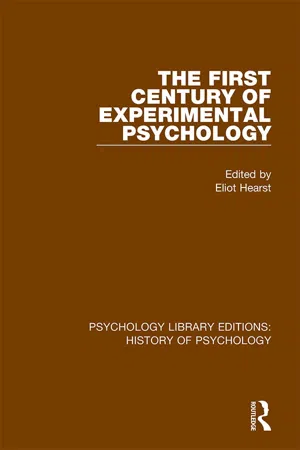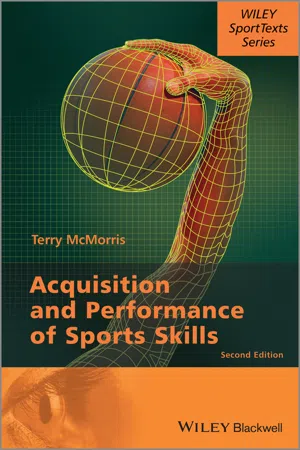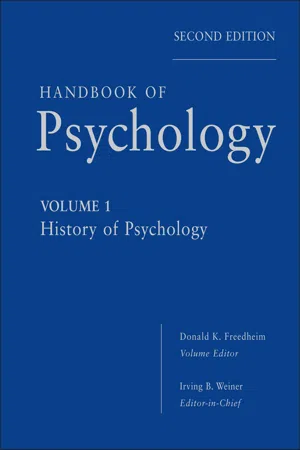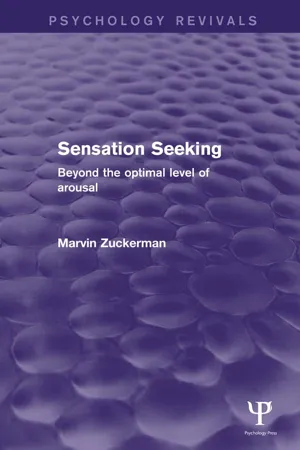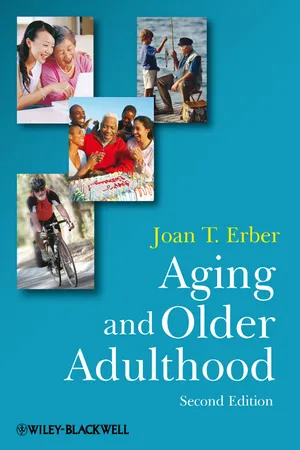Psychology
Sensation and Perception
Sensation refers to the process of detecting and encoding sensory information from the environment, such as seeing, hearing, tasting, touching, and smelling. Perception involves organizing and interpreting the sensory information to make sense of the world. Together, sensation and perception play a crucial role in how individuals experience and understand their surroundings.
Written by Perlego with AI-assistance
Related key terms
7 Key excerpts on "Sensation and Perception"
- Nancy Fenton, Jessica Flitter(Authors)
- 2015(Publication Date)
- Research & Education Association(Publisher)
Chapter 6 Sensation and PerceptionWhat does one know about his or her world? Since the beginning of scientific psychology, psychologists have been interested in understanding Sensation and Perception and how these two interconnected processes relate to cognition and behavior. Psychophysics , a branch of psychology strongly influenced by German scientist Gustav Fechner , studies how physical stimuli (sensations) translate to psychological experiences (perceptions). Sensation involves how an organism receives stimuli and information from the surrounding world via the sensory organs. Psychophysicists investigate the human senses, including vision, audition (hearing), gustation (taste), olfaction (smell), somatic (touch, temperature, pain), vestibular, and kinesthetic. Each sense has specific receptor cells located in the sense organs, which transform physical stimuli into neural impulses in a process known as transduction . The complementary process to sensation is perception , which involves the interpretation of sensations. Perception includes the cognitive processes of receiving, encoding, storing, and organizing sensations.STUDY TIPBe able to distinguish between the processes of sensation and perception .ThresholdsHow intense does a stimulus have to be to produce a sensation? Psychophysicists have answered this question with absolute thresholds , or the minimum intensity of stimulation needed for detection 50 percent of the time. For example, an experimenter attempting to find an individual’s absolute threshold for sound may walk away from the individual with a ticking watch. As soon as the individual cannot reliably hear the watch 50 percent of the time, the experimenter has determined that individual’s approximate absolute threshold for sound.A subliminal stimulus is a weak stimulus presented below threshold that cannot be consciously registered. Research has questioned if very weak or quick stimuli below one’s level of consciousness can be interpreted; this is known as subliminal perception . Although subliminal commands to change behaviors have not been confirmed, there is some evidence that subliminal stimuli may have a subtle influence on behavior, but the influence is neither strong nor long-lasting. Any claims by advertisers that subliminal messages can change complex behaviors, such as ending addictions or learning a new language, are not- eBook - ePub
- Ann L. Weber, Joseph Johnson(Authors)
- 2011(Publication Date)
- Collins Reference(Publisher)
CHAPTER 6Perception
P erception is usually taken to mean the final, organized, and meaningful experience of sensory information. The difference between Sensation and Perception is one of degree of understanding. Sensation (from a Latin word meaning “to feel”) involves the neural stimulation of sensory systems by physical changes, as we saw in Chapter 5. Perception (from the Latin per or “thorough” and capio or “grasp”) involves recognizing the meaning of what has been sensed. Basically, sensation is detecting a stimulus, whereas perception is recognizing a stimulus. That is, when one senses a stimulus, one is aware of it, but when one perceives that stimulus, one understands what it is.STUDYING PERCEPTIONThe study of perception has been guided by different approaches to exactly what the nature of perception is. To a large degree, the study of perception has also been defined by the formal quantitative framework used to analyze perceptual performance. These concepts are introduced here to lay the foundation for the remainder of the chapter.Approaches to PerceptionThere are three primary approaches that describe psychologists who study perception. The ecological approach, founded by James J. Gibson (1904–1979), focuses on the interactions with the environment, in particular how we perceive the cues in the environment that help us to perform specific actions. The constructivist approach is mainly concerned with perceptual inference, or how we use incomplete sensory information to form mental representations. These approaches have contributed a great deal to the more recent computational approach, which attempts to understand the exact computations that a perceptual system performs.Psychophysics RevisitedWe discuss a bit about the historical contributions of psychophysics in Chapter 1 and the application of psychophysics to sensation in Chapter 5. Classical psychophysical studies have examined absolute thresholds - eBook - ePub
- Eliot Hearst(Author)
- 2019(Publication Date)
- Routledge(Publisher)
3 Sensation and PerceptionJulian HochbergColumbia UniversityI. INTRODUCTION
The study of Sensation and Perception is the attempt to explain our experience of the world and its contents, an endeavor that is of critical importance to artists, philosophers, the communications industries, physiologists and physicians, as well as to psychologists. The past century has seen the formulation of innumerable theories intended to explain specific sensory and perceptual phenomena. Standing in a sense above these are a few major theories, offered as general explanations for all such phenomena (and sometimes for psychology in general). These major theories are usually not specific enough themselves to be put to definitive tests, but they offer more far-reaching and summarizable purposes, frameworks, or programs within which the more specific models are explored and tested.I will survey what I take to be the major theories, their purposes, and some relevant findings. The goals, methods, and problems of inquiry in Sensation and Perception have all changed in striking ways in the last 100 years. Although the continuities are real, so are the changes, and these should not be overlooked.Progress in Sensation and Perception during the last century can be roughly divided into four periods. The first period, featuring the classical theory expressed by Helmholtz and Wundt in somewhat different variants, produced a set of general views that probably still completely dominate thinking about perception outside of the field of perceptual theory itself. Within this general approach, which was rooted in earlier speculative philosophy and experimental sensory physiology, the perception of objects and events is to be distinguished from the experiences of simple sensory response to simple physical stimuli, with object perception presumably built up from the elementary sensory responses, or sensations. The term perception as used in this chapter coincides with the study of the former; sensation, with the study of the latter. The second period involved the influence of Gestalt theory - eBook - ePub
- Terry McMorris(Author)
- 2014(Publication Date)
- Wiley(Publisher)
2 Sensation and Perception of External InformationLearning objectives
At the end of this chapter, you should be able to:- understand what is meant by indirect or inferred perception
- describe how information processing theorists explain perception, with particular reference to:
- – signal detection theory
- – nature and role of selective attention
- – nature and role of visual search
- – how individual differences affect perception
- understand what is meant by direct perception
- have a basic knowledge of how ecological psychologists explain perception, including
- – nature and importance of affordances
- – how perception and action interact to detect affordances
- understand the main criticisms of information processing and ecological psychology theories with regard to perception
- be aware of the main developmental factors affecting perception.
In this chapter we examine, from an information processing perspective, how we perceive external information particularly for the purposes of making decisions. From an ecological psychology stand point, we are looking at how perception and action combine to recognize the existence of affordances in the environment. The role of perception in the control of movement is covered in Chapter 6 .Information processing theory, Sensation and Perception
Although information processing theorists argue that sensation and perception are different, the two concepts tend to be treated as one. The senses, which are the most important in the perception of information for decision making, are visual and auditory receptors. Vision is generally considered to be the most important of the senses. Light rays enter the eye through the lens and are detected by the retina. The central portion of the eye, the fovea, is rich in nerve receptors, which allow it to extract detail from an object. The range of foveal or central vision depends on how the eye is focused. This is controlled by the ciliary muscles, which are on either side of the lens. The range is generally regarded as being between 2° and 5°. The vision outside of this range is referred to as peripheral vision. The receptors, here, are less dense and images are less distinct than those found in foveal vision. Although foveal and peripheral vision are commonly used terms, Trevarthen (1968) used the terms focal and ambient vision. Focal vision is identical to foveal vision, but ambient vision differs a little to peripheral vision. According to Trevarthen, ambient vision - eBook - ePub
- (Author)
- 2012(Publication Date)
- Wiley(Publisher)
Chapter 5 Sensation and Perception Stanley Coren The Perceptual Problem Sensation, Perception, Reason, and Cognition Physics and Visual Perception Physiology and Perception The Science of Illusion The Rise of the Behavioral Laboratories The Psychophysicists and the Correspondence Problem The Gestaltists and the Correspondence Problem The Progress of Perceptual Research Bibliography ReferencesThe study of Sensation and Perception covers many diverse topics. This is partly the result of the length of time that perceptual problems have been studied. The ancient Greek philosophers some 2,500 years ago were already investigating this topic, and they were followed by the pre-Renaissance thinkers, the Arabic scholars, the Latin scholastics, the early British empiricists, the German physicists, and the German physicians who founded both physiology and psychology; all considered issues in Sensation and Perception to be basic questions. When Alexander Bain (1855) wrote the first English textbook on psychology, it was entitled The Senses and the Intellect, with the most extensive coverage reserved for sensory and perceptual functions. During the first half of his career, Wilhelm Wundt (who is generally credited with the founding of experimental psychology) focused much of his research on sensory and perceptual issues.Because there is such a long history of perceptual research, it is not surprising that we have amassed a huge database covering substantive issues about how the specific sensory systems operate and how we extract and interpret information from them. It would be possible to write a multivolume book just on the history of visual perception, another on auditory perception, or yet other volumes on the history of sensory and perceptual studies of the tactile, olfactory, or gustatory modalities. Even specific aspects of perception, such as the perception of pain, could generate their own full volume outlining the history of the major substantive findings and theoretical treatments of this single aspect of sensory experience. In addition to the large empirical database that has resulted from the long history of research in this area, the study of perception has been affected by many schools of thought. Each has its own major theoretical viewpoint and its own particular set of methodological techniques. Thus, we encounter psychophysicists, gestaltists, functionalists, structuralists, transactionalists, sensory physiologists, analytic introspectionists, sensory-tonic theorists, “new look” psychologists, efferent theorists, cognitive theorists, information processors, artificial intelligence experts, and computational psychologists, to name but a few. There are even theorists (such as some behaviorists) who deny the existence of, or at least deny our ability to study, the conscious event we call perception. How, then, can a single chapter give any coherent treatment of the issues associated with this fundamental aspect of psychology? - eBook - ePub
Sensation Seeking (Psychology Revivals)
Beyond the Optimal Level of Arousal
- Marvin Zuckerman(Author)
- 2014(Publication Date)
- Psychology Press(Publisher)
8 Sensation, Perception, and Cognition—KeatsO for a life of sensations rather than of thoughts .A basic personality trait is likely to affect styles and modes of information processing. Since the “new look” in perception in the 1950s, psychologists have been intrigued with the role of perception and cognition within broader, reliable personality dimensions. One perceptual trait, field independence-dependence, has become the basis for an entire approach to personality (Witkin, Lewis, Hertzman, Machover, Meissner, & Wagner, 1954/1972). Eysenck also has made extensive use of perceptual-motor tasks in testing his theory of extraversion. However, one cannot be too sanguine about the possibilities of finding reliable relationships between sensation, perception, or learning variables and a personality trait like sensation seeking. As Eysenck and others working in this area have come to realize, a slight change in the parameters of the laboratory method can produce or wipe out a relationship with personality measures. Few investigators have the inclination or patience to explore the parameters of the laboratory task in relation to personality in a systematic way. This leads to a situation of many unreplicated findings lying around like junked cars in the back lots of psychological research.Chapter OutlineBoth the Pavlovian theory of the “strength of the nervous system” and optimal level of stimulation theory would predict that high- and low-sensation seekers should be differentiated by the lows’ greater sensitivity to low-intensity stimulation and the highs’ greater tolerance for high-intensity stimulation. Studies of sensory thresholds and pain thresholds and tolerance are reviewed, and the relevance of the results for these theories is assessed.Inhibition theories of sensation seeking lead to the prediction that highsensation seekers will rapidly generate inhibition when stimulation is repetitious or constant. Results of perceptual satiation studies, such as alternation of reversible figures and the verbal transformation illusion, are reviewed for their relevance to these theories. - eBook - ePub
- Joan T. Erber(Author)
- 2011(Publication Date)
- Wiley-Blackwell(Publisher)
Sensory ProcessesBernie just celebrated his 67th birthday and lately he has noticed that the local newspaper is becoming difficult to read comfortably. He must hold it at arm’s length to decipher the print. He thinks he will cancel his subscription and just read the news on-line or tune in to the cable news channels. Also, for the past two years, he and his wife have been meeting with a group of retired friends for weekly lunches at a local diner. Bernie finds these get-togethers are not as enjoyable as they could be because his friends mumble and he must strain to hear what they are saying, especially when several of them talk at once. Between the clatter of dishes, the piped-in music, and the background chatter at surrounding tables, it is a challenge to keep up with, let alone stay involved in, meaningful conversation. Bernie is going to suggest to his wife that they get together with one or two friends at a time, perhaps in each other’s homes, where there will be less noise and fewer distractions.To adapt to and interact with the environment we must be able to take in, or register, what is going on around us. For this purpose we depend upon our eyes, ears, nose, and other sensory organs, through which we experience our initial contact with stimulus events and objects in our environment. Our senses include taste, smell, touch, vision, and hearing. Researchers who study aging have noted the importance of sensory processes; according to the common cause hypothesis, the link between sensory processes and cognitive functioning becomes stronger in older adulthood than it was earlier in life (Baltes & Lindenberger, 1997).Although age-related differences in cognitive functioning may not be fully explained by sensory declines (Anstey, Luszcz, & Sanchez, 2001; Lindenberger, Scherer, & Baltes, 2001), there is little question that having good sensory capabilities is related to good memory and verbal abilities (Schneider & Pichora-Fuller, 2000; Wingfield, Tun, & McCoy, 2005). Also, having good sensory capabilities, particularly vision and hearing, is associated with the ability to perform self-care activities (for example, bathing, dressing, and grooming), to do household chores and go shopping (Marsiske, Klumb, & Baltes, 1997), and to take part in social activities.Once the sensory organs register it, information can be passed along to the central nervous system for higher-level, perceptual processing, which entails interpreting what the information means and making decisions about how to respond. Often, there is more information in our environment than we can possibly register, let alone process, at any given time. Attention has to do with exactly what information we will process from the large array of stimuli that impinge upon our senses.
Learn about this page
Index pages curate the most relevant extracts from our library of academic textbooks. They’ve been created using an in-house natural language model (NLM), each adding context and meaning to key research topics.


